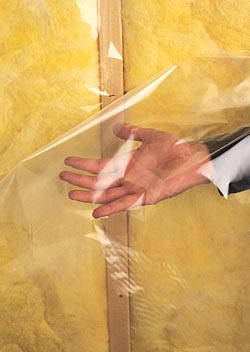
Image Credit: CertainTeed Corp.
9 Steps to A Greener Code
New homes built using the 2009 International Residential Code (IRC) or International Energy Conservation Code (IECC) will be more energy efficient than ever. As a consequence, a builder’s world may become a bit more complex and, in some cases, a bit more expensive.
STEP 9: INSTALLING VAPOR RETARDERS
Code: R601.3 Class-I or -II vapor retarders are required on the interior side of framed walls in zones 5, 6, 7, and 8 and in Marine 4, except on basement walls; in the below-grade portion of any wall; and in construction where moisture or frozen moisture will not damage the materials used in the assembly.
What it means to you: Since the last edition of the IRC, the vapor-retarder requirements in the IECC, IRC, and IBC were changed based on an understanding of building science. This change moves the new vapor-retarder requirements into their proper code
location because they are more reasonably related to the building shell. This means that in the prescribed zones, you’ll need to install a vapor retarder on the interior side of a wall. A class-III vapor retarder can be used in lieu of class-I and -II products in some cases when the cladding is vented or insulated sheathing is used. This code, which was previously only part of the IECC, is now integrated into the IRC.
The 2009 building codes reflect practices that not only increase energy efficiency, like air sealing measures and increased insulation, but also address sustainable building practices, like moisture control.
Other segments of this series:
Part 4: Programmable Thermostats
Part 7: Insulating Mechanical Pipes
Part 8: Exceeding the Energy Code
Weekly Newsletter
Get building science and energy efficiency advice, plus special offers, in your inbox.














0 Comments
Log in or create an account to post a comment.
Sign up Log in